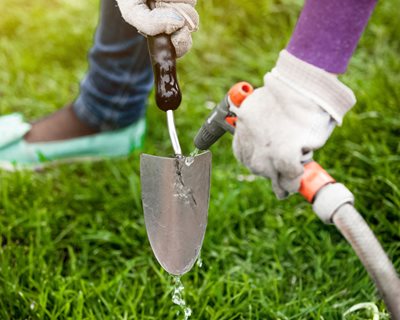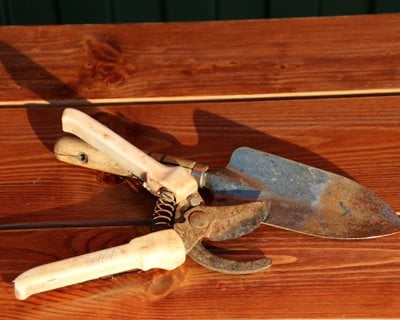How to Care for Garden Tools
Advice for daily and seasonal care and maintenance for garden tools, including cleaning and storage
Photo by: kryzhov / Shutterstock.
A regular maintenance routine keeps your garden tools in good working order and helps them last longer. Tools not only need to be sharp, but also clean and sterile. Tools that are exposed to plants or soil with bacterial, fungal or insect infestations can spread those problems throughout the garden. It only takes a few minutes after each gardening session to take care of your tools and protect your garden the next time they are used.
DAILY MAINTENANCE
Keeping your tools clean and storing them properly after each use is essential if you want them to last.
Here are some general tips:
- Rinse digging tools with a garden hose and use a wire brush or putty knife to get rid of caked-on dirt.
- Give pruners, loppers or shears, a quick scrub with a nail brush and some soapy water.
- If tools were exposed to diseased plants or pest-infected soil, give them a quick soak in a diluted solution of 2 cups household bleach mixed with 1 gallon of water, then rinse in plain water, or wipe with a cotton pad soaked with rubbing alcohol.
- Always dry your tools thoroughly with a towel or rag.
- Keep a bucket of sand mixed with a plant-based oil, such as boiled linseed oil, handy for metal digging tools. The sand should be damp, but not wet. Plunge the blade, tines, or teeth into the sand a few times for a quick clean or do this following regular maintenance once the tools are dry. The oil helps protect the metal surface from rust and corrosion.
- Avoid using petroleum products, such as motor oil, because the next time you use the tool, you’ll be introducing petroleum into your soil.
- Keep disinfecting wipes handy to remove sap, bacteria and fungus for a quick clean-up on the fly.
- Store tools in a dry, well-ventilated shed or garage. Smaller hand tools can be stored plunged into a bucket of sand or small pebbles, and larger tools should be hung or stored upside down so as not to dull their blades.
Boiled linseed oil can be used to condition the wood handles and protect the metal working parts of tools. When applied to the metal parts, it creates a barrier between the metal and oxygen, preventing rust. For a thorough treatment, apply it liberally over the entire tool, allow it to sit 15 mins and wipe off the excess with a dry cloth. Read and follow the directions carefully, as used rags can pose a combustion risk if stored or disposed of incorrectly.
Removing Sap
Pruner blades that are clogged with sap can be difficult to use. Solvents, such as mineral spirits or turpentine, can be used to remove sap from pruning tool blades.
- Wipe blades with a cotton ball or cloth dipped in solvent.
- Clean the blades with soapy water and treat with linseed oil after using solvents.

Photo by: photowind / Shutterstock.
Preventing and Removing Rust
Making sure tools are dried thoroughly before storing and treating them with linseed or mineral oil are the best ways to keep tools from getting rusty. But, if you do discover some rust on your tools, here’s what you can do to get them back in working order:
- Soak in a 1:1 mixture of vinegar and water overnight.
- Scrub in a circular motion with steel wool.
- Rinse in soapy water, and then plain water.
- Let dry thoroughly, then rub lightly with linseed or mineral oil.
SEASONAL TOOL CARE
Care for pruners, loppers, or shears
In addition to daily maintenance, pruners should be taken apart and deep cleaned at least once each season. This can be done at the end of the season before storing tools for winter.
- Unscrew the nut that holds them together and wash all parts separately in soapy water.
- Soak in vinegar and water and scrub with steel wool to remove any rust; rinse and dry.
- Soak in bleach and water to sanitize; rinse and dry.
- Rub with boiled linseed oil and reassemble.
Keep your tools sharp
Cutting or pruning with dull blades often results in damaged branches that have been ripped or torn apart, making them more susceptible to disease. Keep your pruners and other cutting tools sharp with a specialized pruner-sharpening tool or a sharpening stone. Other tools such as hoes, shovels, and knives can be kept sharp with quick touchups from a sharpening file, followed by a sharpening stone.
- Push the file or sharpener in the same direction (not back and forth) across the blade and follow the original bevel angle.
- Further smooth filed edges with a sharpening stone.
- Wear eye protection and heavy gloves when using any sharpening equipment to protect against metal slivers.
Wood handles
Don’t forget to take care of the wood handles as well. Minor cracks can be reinforced with heavy duty tape, such as hockey-stick tape. Any severely cracked handles should be replaced immediately to prevent an injury if it should break while being used.
- After each use, wipe down the handles with a damp cloth.
- Check for cracks or weakening at seams between the handle and the tool head and address any issues.
- Seasonally, or as needed, lightly sand and apply boiled linseed oil to condition the handles.
Related:
12 Essential Gardening Tools
10 Gardening Tools the Experts are Using
When you purchase products through links on our site, we may receive an affiliate commission. Thank you for your support.
